Understanding Multiple Sclerosis: Causes, Symptoms, and Treatment of the Nervous System Disease
VerifiedAdded on 2023/04/24
|13
|3461
|105
AI Summary
In this document we will discuss about Understanding Multiple Sclerosis and below are the summary points of this document:-
Multiple sclerosis (MS) is a disease that affects the brain and spinal cord, damaging the myelin sheath that protects nerve cells.
The prevalence of MS varies across different regions, with higher rates in western and northern Europe, southern Australia, and northern regions of the United States.
MS primarily affects women and can lead to symptoms such as paralysis, difficulty walking, numbness, and vision loss. Treatment aims to manage symptoms and slow down disease progression.
Contribute Materials
Your contribution can guide someone’s learning journey. Share your
documents today.
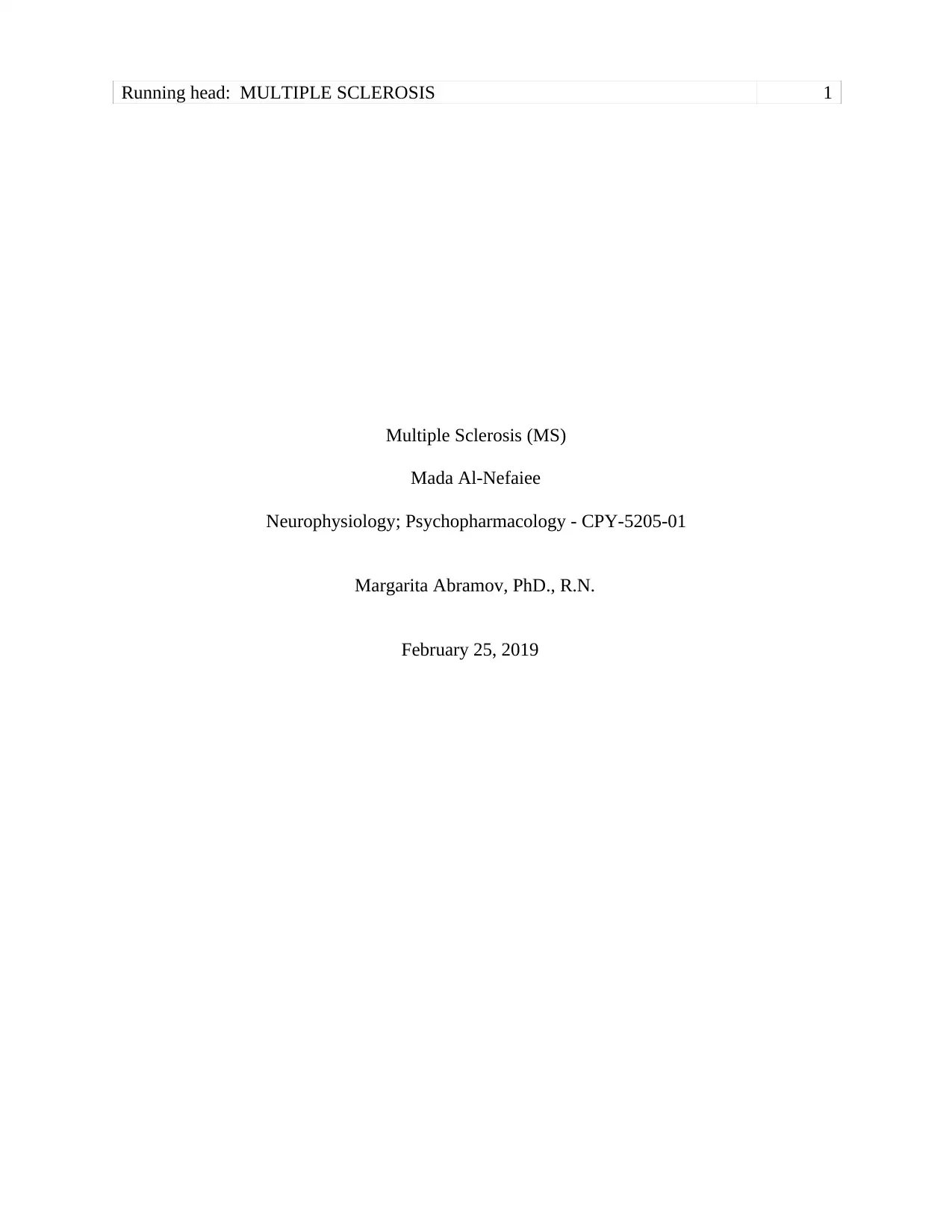
Running head: MULTIPLE SCLEROSIS 1
Multiple Sclerosis (MS)
Mada Al-Nefaiee
Neurophysiology; Psychopharmacology - CPY-5205-01
Margarita Abramov, PhD., R.N.
February 25, 2019
Multiple Sclerosis (MS)
Mada Al-Nefaiee
Neurophysiology; Psychopharmacology - CPY-5205-01
Margarita Abramov, PhD., R.N.
February 25, 2019
Secure Best Marks with AI Grader
Need help grading? Try our AI Grader for instant feedback on your assignments.

Multiple Sclerosis 2
Abstract
The term "many scars" refers to the slit, which is generated during the period of brain and
spinal cord disease in Multiple sclerosis (MS) (Joy & Johnston, 2001). Spinal Cord and brain is
affected in the disease of nervous system Multiple sclerosis. The disease damages the materials,
which protects and surrounds nerve cells. The material is known as myelin sheath. The messages
form an individual’s brain to the body is blocked in the course of this damage ("Multiple
Sclerosis | MS | MedlinePlus," 2019). As per Morales, Parisi, and Lucchinetti (2006), the
demolition of myelin sheaths, which surrounds the axons or nerve fiber of the neurons, marks the
primary injury from the disease Multiple sclerosis. MS also damages the axons along with the
myelin sheaths. One in every 2,000 to 2,400 people are affected by this disease in the areas of
western and northern Europe, southern Australia, Russia and northern regions of United States.
In the regions around the equator, the prevalence of this disease is less. The data of the MS
affected people in the regions of Asia, parts of South America and in sub-Saharan Africa
portrays the lower rate of damages, which is about one in 20,000. Due to unspecified reasons,
women gets affected twice as frequent as compared to men from the various forms of multiple
sclerosis (NIH, 2019).
Key words: MRI = magnetic resonance imaging, Multiple sclerosis, CNS= central nervous
system, CSF = cerebrospinal fluid,
Abstract
The term "many scars" refers to the slit, which is generated during the period of brain and
spinal cord disease in Multiple sclerosis (MS) (Joy & Johnston, 2001). Spinal Cord and brain is
affected in the disease of nervous system Multiple sclerosis. The disease damages the materials,
which protects and surrounds nerve cells. The material is known as myelin sheath. The messages
form an individual’s brain to the body is blocked in the course of this damage ("Multiple
Sclerosis | MS | MedlinePlus," 2019). As per Morales, Parisi, and Lucchinetti (2006), the
demolition of myelin sheaths, which surrounds the axons or nerve fiber of the neurons, marks the
primary injury from the disease Multiple sclerosis. MS also damages the axons along with the
myelin sheaths. One in every 2,000 to 2,400 people are affected by this disease in the areas of
western and northern Europe, southern Australia, Russia and northern regions of United States.
In the regions around the equator, the prevalence of this disease is less. The data of the MS
affected people in the regions of Asia, parts of South America and in sub-Saharan Africa
portrays the lower rate of damages, which is about one in 20,000. Due to unspecified reasons,
women gets affected twice as frequent as compared to men from the various forms of multiple
sclerosis (NIH, 2019).
Key words: MRI = magnetic resonance imaging, Multiple sclerosis, CNS= central nervous
system, CSF = cerebrospinal fluid,
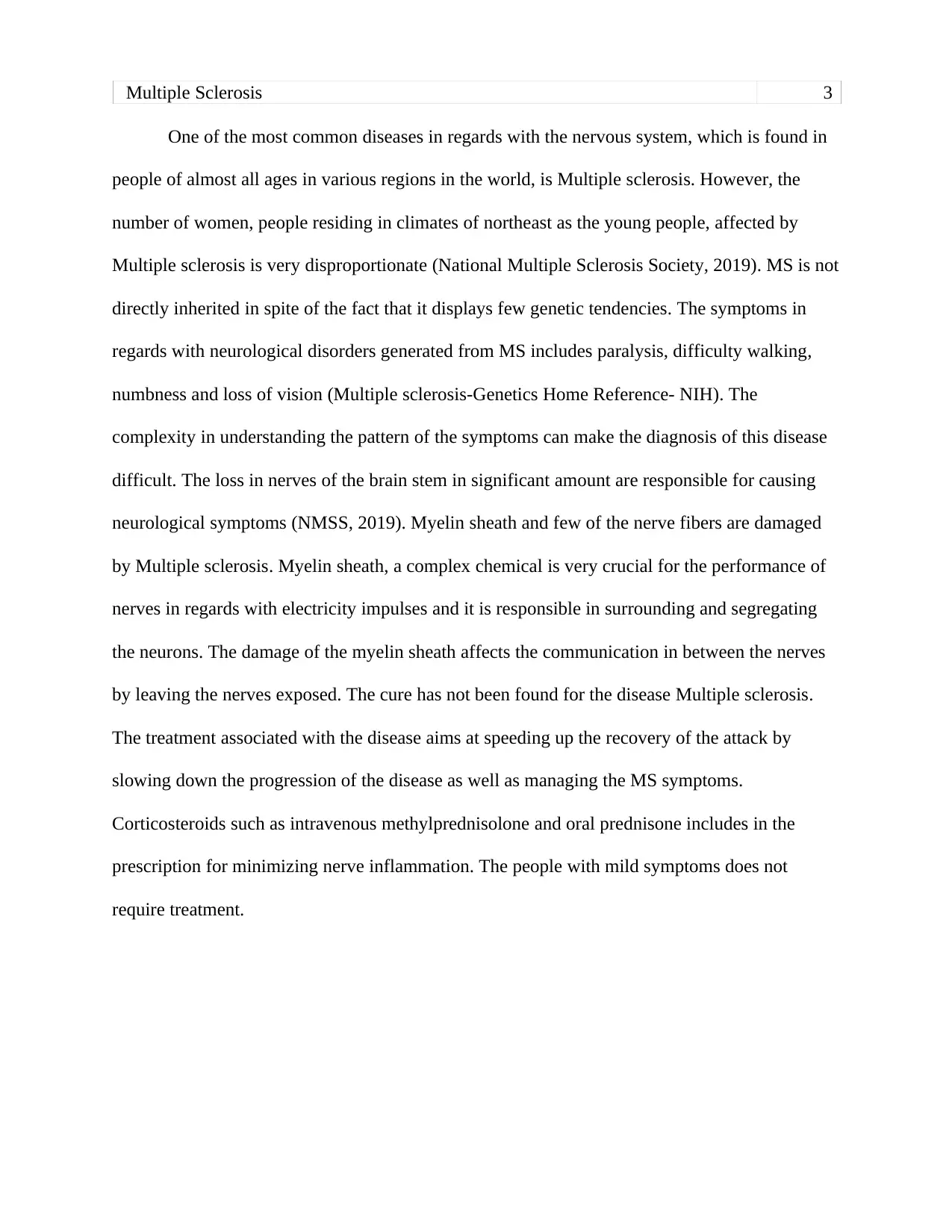
Multiple Sclerosis 3
One of the most common diseases in regards with the nervous system, which is found in
people of almost all ages in various regions in the world, is Multiple sclerosis. However, the
number of women, people residing in climates of northeast as the young people, affected by
Multiple sclerosis is very disproportionate (National Multiple Sclerosis Society, 2019). MS is not
directly inherited in spite of the fact that it displays few genetic tendencies. The symptoms in
regards with neurological disorders generated from MS includes paralysis, difficulty walking,
numbness and loss of vision (Multiple sclerosis-Genetics Home Reference- NIH). The
complexity in understanding the pattern of the symptoms can make the diagnosis of this disease
difficult. The loss in nerves of the brain stem in significant amount are responsible for causing
neurological symptoms (NMSS, 2019). Myelin sheath and few of the nerve fibers are damaged
by Multiple sclerosis. Myelin sheath, a complex chemical is very crucial for the performance of
nerves in regards with electricity impulses and it is responsible in surrounding and segregating
the neurons. The damage of the myelin sheath affects the communication in between the nerves
by leaving the nerves exposed. The cure has not been found for the disease Multiple sclerosis.
The treatment associated with the disease aims at speeding up the recovery of the attack by
slowing down the progression of the disease as well as managing the MS symptoms.
Corticosteroids such as intravenous methylprednisolone and oral prednisone includes in the
prescription for minimizing nerve inflammation. The people with mild symptoms does not
require treatment.
One of the most common diseases in regards with the nervous system, which is found in
people of almost all ages in various regions in the world, is Multiple sclerosis. However, the
number of women, people residing in climates of northeast as the young people, affected by
Multiple sclerosis is very disproportionate (National Multiple Sclerosis Society, 2019). MS is not
directly inherited in spite of the fact that it displays few genetic tendencies. The symptoms in
regards with neurological disorders generated from MS includes paralysis, difficulty walking,
numbness and loss of vision (Multiple sclerosis-Genetics Home Reference- NIH). The
complexity in understanding the pattern of the symptoms can make the diagnosis of this disease
difficult. The loss in nerves of the brain stem in significant amount are responsible for causing
neurological symptoms (NMSS, 2019). Myelin sheath and few of the nerve fibers are damaged
by Multiple sclerosis. Myelin sheath, a complex chemical is very crucial for the performance of
nerves in regards with electricity impulses and it is responsible in surrounding and segregating
the neurons. The damage of the myelin sheath affects the communication in between the nerves
by leaving the nerves exposed. The cure has not been found for the disease Multiple sclerosis.
The treatment associated with the disease aims at speeding up the recovery of the attack by
slowing down the progression of the disease as well as managing the MS symptoms.
Corticosteroids such as intravenous methylprednisolone and oral prednisone includes in the
prescription for minimizing nerve inflammation. The people with mild symptoms does not
require treatment.
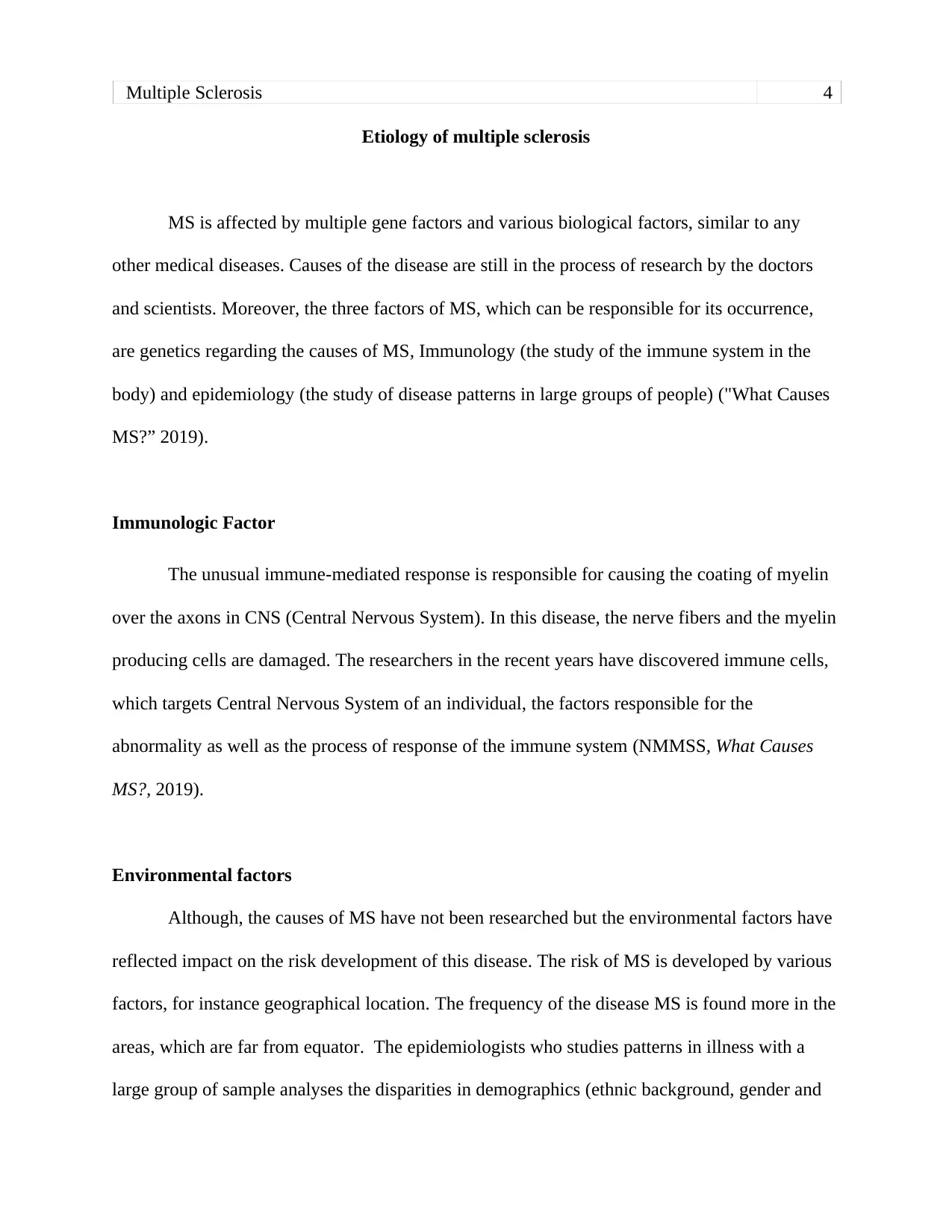
Multiple Sclerosis 4
Etiology of multiple sclerosis
MS is affected by multiple gene factors and various biological factors, similar to any
other medical diseases. Causes of the disease are still in the process of research by the doctors
and scientists. Moreover, the three factors of MS, which can be responsible for its occurrence,
are genetics regarding the causes of MS, Immunology (the study of the immune system in the
body) and epidemiology (the study of disease patterns in large groups of people) ("What Causes
MS?” 2019).
Immunologic Factor
The unusual immune-mediated response is responsible for causing the coating of myelin
over the axons in CNS (Central Nervous System). In this disease, the nerve fibers and the myelin
producing cells are damaged. The researchers in the recent years have discovered immune cells,
which targets Central Nervous System of an individual, the factors responsible for the
abnormality as well as the process of response of the immune system (NMMSS, What Causes
MS?, 2019).
Environmental factors
Although, the causes of MS have not been researched but the environmental factors have
reflected impact on the risk development of this disease. The risk of MS is developed by various
factors, for instance geographical location. The frequency of the disease MS is found more in the
areas, which are far from equator. The epidemiologists who studies patterns in illness with a
large group of sample analyses the disparities in demographics (ethnic background, gender and
Etiology of multiple sclerosis
MS is affected by multiple gene factors and various biological factors, similar to any
other medical diseases. Causes of the disease are still in the process of research by the doctors
and scientists. Moreover, the three factors of MS, which can be responsible for its occurrence,
are genetics regarding the causes of MS, Immunology (the study of the immune system in the
body) and epidemiology (the study of disease patterns in large groups of people) ("What Causes
MS?” 2019).
Immunologic Factor
The unusual immune-mediated response is responsible for causing the coating of myelin
over the axons in CNS (Central Nervous System). In this disease, the nerve fibers and the myelin
producing cells are damaged. The researchers in the recent years have discovered immune cells,
which targets Central Nervous System of an individual, the factors responsible for the
abnormality as well as the process of response of the immune system (NMMSS, What Causes
MS?, 2019).
Environmental factors
Although, the causes of MS have not been researched but the environmental factors have
reflected impact on the risk development of this disease. The risk of MS is developed by various
factors, for instance geographical location. The frequency of the disease MS is found more in the
areas, which are far from equator. The epidemiologists who studies patterns in illness with a
large group of sample analyses the disparities in demographics (ethnic background, gender and
Secure Best Marks with AI Grader
Need help grading? Try our AI Grader for instant feedback on your assignments.
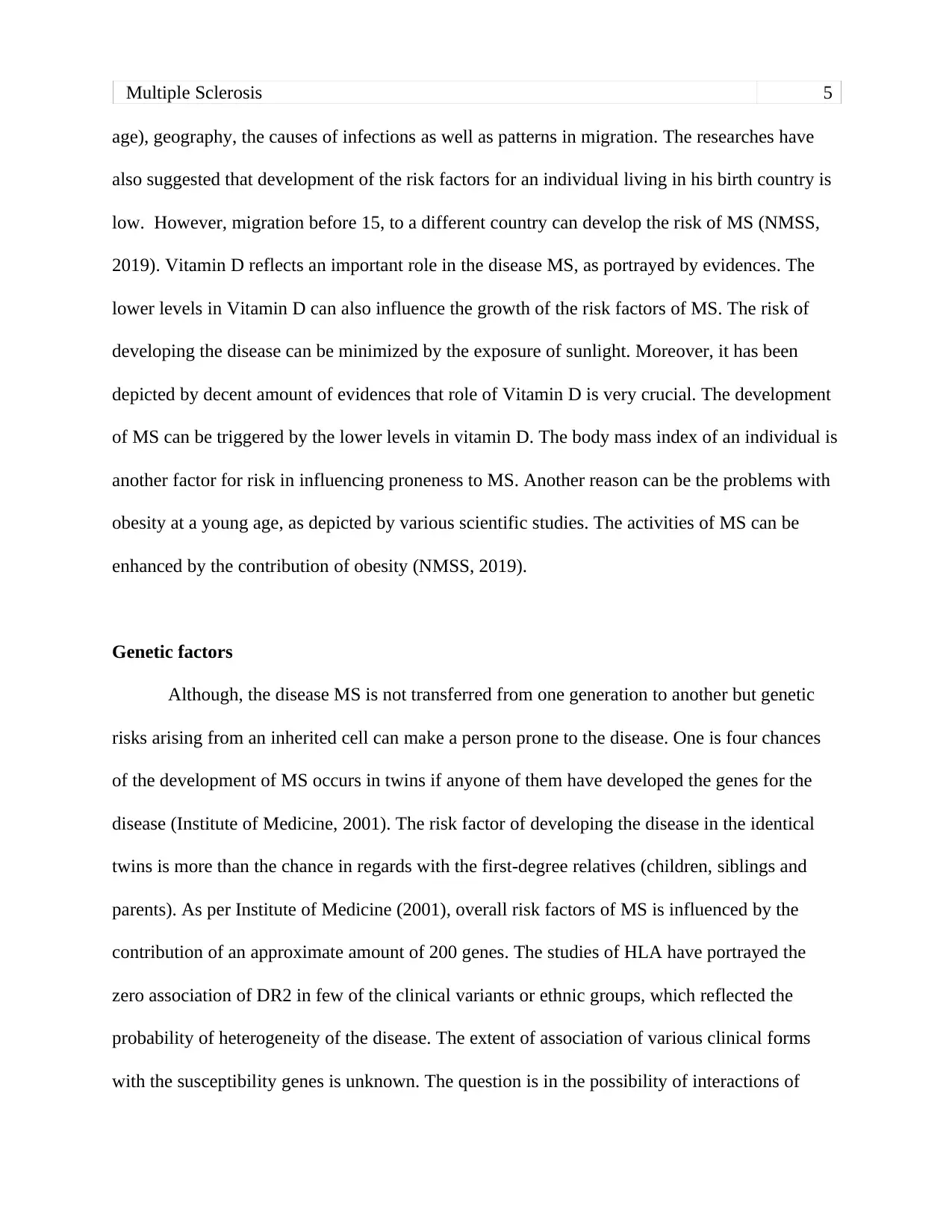
Multiple Sclerosis 5
age), geography, the causes of infections as well as patterns in migration. The researches have
also suggested that development of the risk factors for an individual living in his birth country is
low. However, migration before 15, to a different country can develop the risk of MS (NMSS,
2019). Vitamin D reflects an important role in the disease MS, as portrayed by evidences. The
lower levels in Vitamin D can also influence the growth of the risk factors of MS. The risk of
developing the disease can be minimized by the exposure of sunlight. Moreover, it has been
depicted by decent amount of evidences that role of Vitamin D is very crucial. The development
of MS can be triggered by the lower levels in vitamin D. The body mass index of an individual is
another factor for risk in influencing proneness to MS. Another reason can be the problems with
obesity at a young age, as depicted by various scientific studies. The activities of MS can be
enhanced by the contribution of obesity (NMSS, 2019).
Genetic factors
Although, the disease MS is not transferred from one generation to another but genetic
risks arising from an inherited cell can make a person prone to the disease. One is four chances
of the development of MS occurs in twins if anyone of them have developed the genes for the
disease (Institute of Medicine, 2001). The risk factor of developing the disease in the identical
twins is more than the chance in regards with the first-degree relatives (children, siblings and
parents). As per Institute of Medicine (2001), overall risk factors of MS is influenced by the
contribution of an approximate amount of 200 genes. The studies of HLA have portrayed the
zero association of DR2 in few of the clinical variants or ethnic groups, which reflected the
probability of heterogeneity of the disease. The extent of association of various clinical forms
with the susceptibility genes is unknown. The question is in the possibility of interactions of
age), geography, the causes of infections as well as patterns in migration. The researches have
also suggested that development of the risk factors for an individual living in his birth country is
low. However, migration before 15, to a different country can develop the risk of MS (NMSS,
2019). Vitamin D reflects an important role in the disease MS, as portrayed by evidences. The
lower levels in Vitamin D can also influence the growth of the risk factors of MS. The risk of
developing the disease can be minimized by the exposure of sunlight. Moreover, it has been
depicted by decent amount of evidences that role of Vitamin D is very crucial. The development
of MS can be triggered by the lower levels in vitamin D. The body mass index of an individual is
another factor for risk in influencing proneness to MS. Another reason can be the problems with
obesity at a young age, as depicted by various scientific studies. The activities of MS can be
enhanced by the contribution of obesity (NMSS, 2019).
Genetic factors
Although, the disease MS is not transferred from one generation to another but genetic
risks arising from an inherited cell can make a person prone to the disease. One is four chances
of the development of MS occurs in twins if anyone of them have developed the genes for the
disease (Institute of Medicine, 2001). The risk factor of developing the disease in the identical
twins is more than the chance in regards with the first-degree relatives (children, siblings and
parents). As per Institute of Medicine (2001), overall risk factors of MS is influenced by the
contribution of an approximate amount of 200 genes. The studies of HLA have portrayed the
zero association of DR2 in few of the clinical variants or ethnic groups, which reflected the
probability of heterogeneity of the disease. The extent of association of various clinical forms
with the susceptibility genes is unknown. The question is in the possibility of interactions of
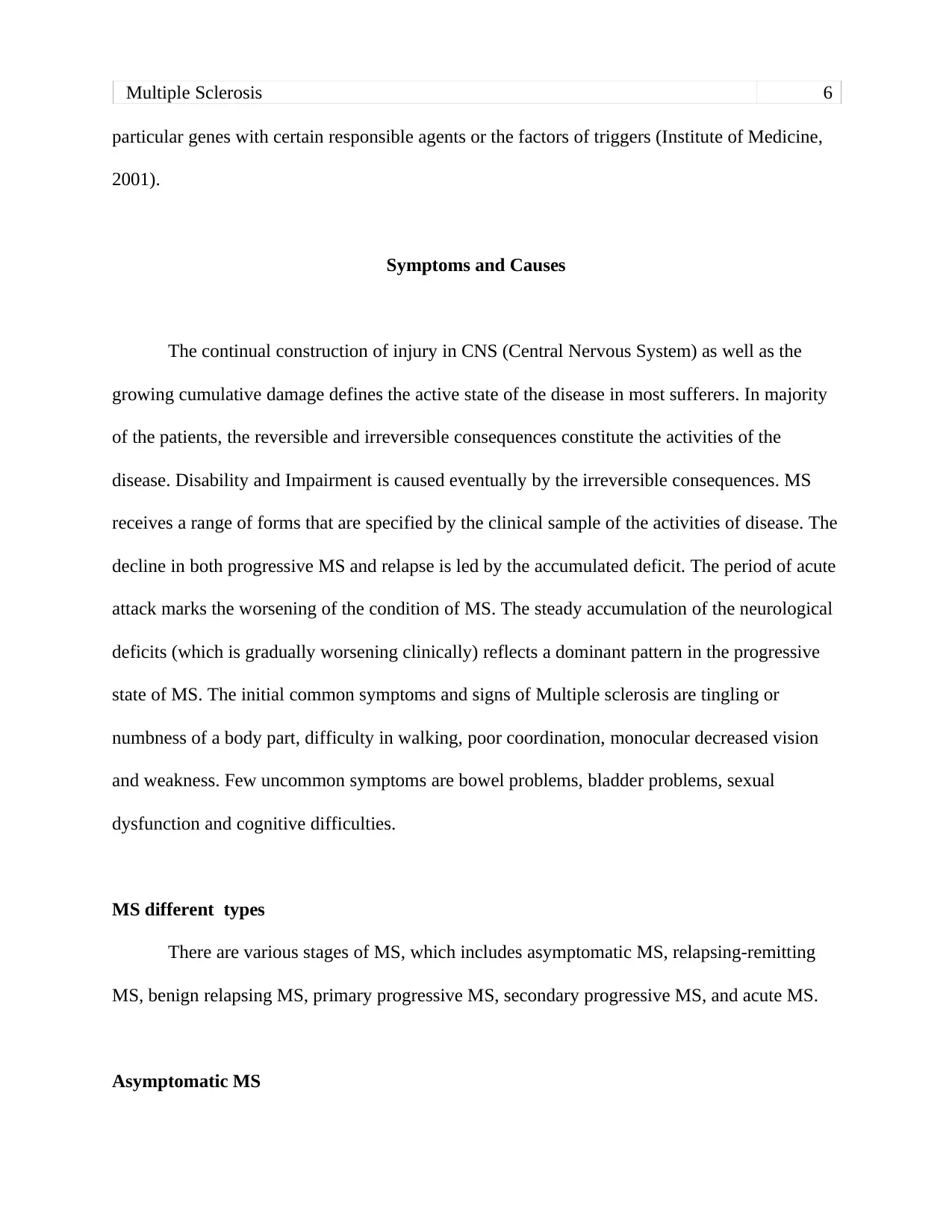
Multiple Sclerosis 6
particular genes with certain responsible agents or the factors of triggers (Institute of Medicine,
2001).
Symptoms and Causes
The continual construction of injury in CNS (Central Nervous System) as well as the
growing cumulative damage defines the active state of the disease in most sufferers. In majority
of the patients, the reversible and irreversible consequences constitute the activities of the
disease. Disability and Impairment is caused eventually by the irreversible consequences. MS
receives a range of forms that are specified by the clinical sample of the activities of disease. The
decline in both progressive MS and relapse is led by the accumulated deficit. The period of acute
attack marks the worsening of the condition of MS. The steady accumulation of the neurological
deficits (which is gradually worsening clinically) reflects a dominant pattern in the progressive
state of MS. The initial common symptoms and signs of Multiple sclerosis are tingling or
numbness of a body part, difficulty in walking, poor coordination, monocular decreased vision
and weakness. Few uncommon symptoms are bowel problems, bladder problems, sexual
dysfunction and cognitive difficulties.
MS different types
There are various stages of MS, which includes asymptomatic MS, relapsing-remitting
MS, benign relapsing MS, primary progressive MS, secondary progressive MS, and acute MS.
Asymptomatic MS
particular genes with certain responsible agents or the factors of triggers (Institute of Medicine,
2001).
Symptoms and Causes
The continual construction of injury in CNS (Central Nervous System) as well as the
growing cumulative damage defines the active state of the disease in most sufferers. In majority
of the patients, the reversible and irreversible consequences constitute the activities of the
disease. Disability and Impairment is caused eventually by the irreversible consequences. MS
receives a range of forms that are specified by the clinical sample of the activities of disease. The
decline in both progressive MS and relapse is led by the accumulated deficit. The period of acute
attack marks the worsening of the condition of MS. The steady accumulation of the neurological
deficits (which is gradually worsening clinically) reflects a dominant pattern in the progressive
state of MS. The initial common symptoms and signs of Multiple sclerosis are tingling or
numbness of a body part, difficulty in walking, poor coordination, monocular decreased vision
and weakness. Few uncommon symptoms are bowel problems, bladder problems, sexual
dysfunction and cognitive difficulties.
MS different types
There are various stages of MS, which includes asymptomatic MS, relapsing-remitting
MS, benign relapsing MS, primary progressive MS, secondary progressive MS, and acute MS.
Asymptomatic MS
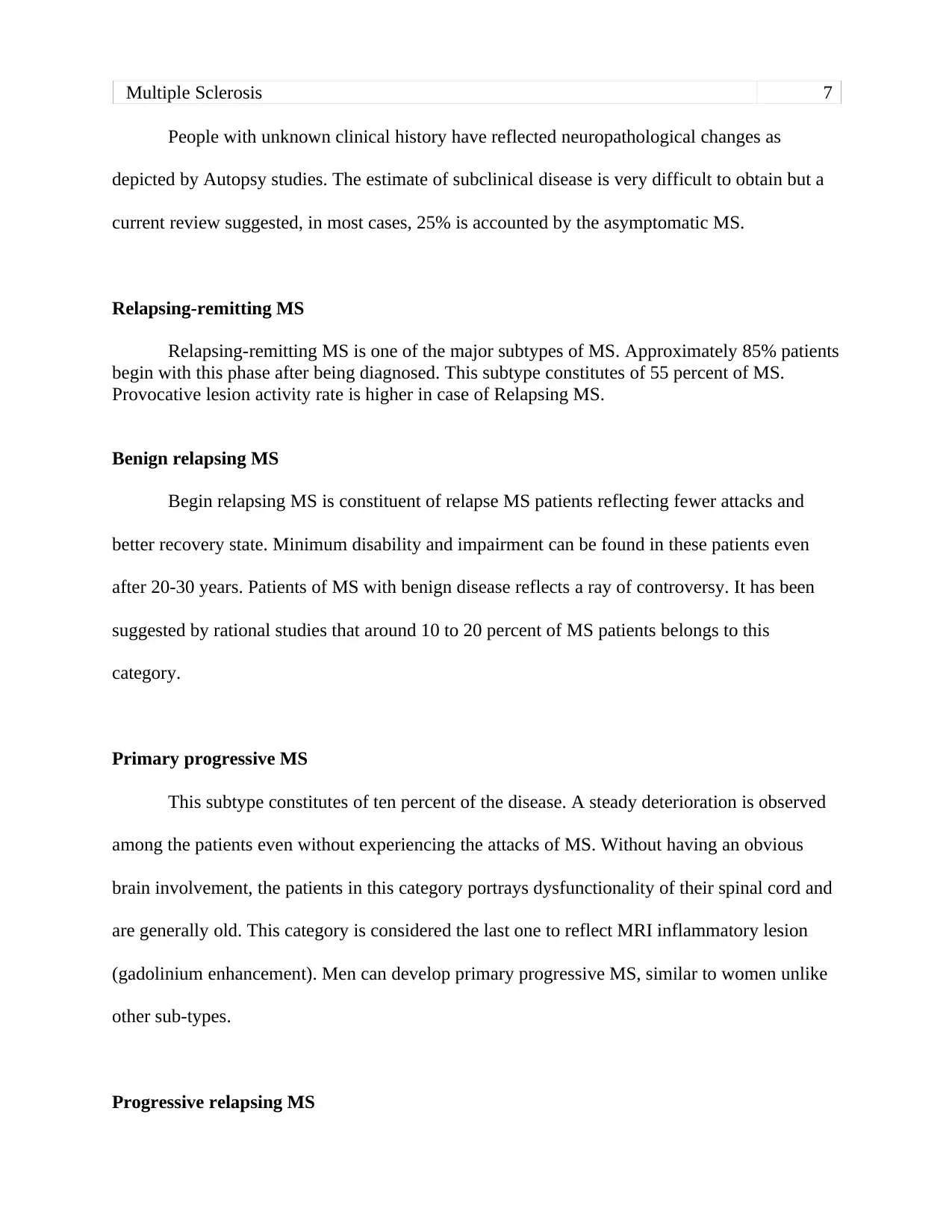
Multiple Sclerosis 7
People with unknown clinical history have reflected neuropathological changes as
depicted by Autopsy studies. The estimate of subclinical disease is very difficult to obtain but a
current review suggested, in most cases, 25% is accounted by the asymptomatic MS.
Relapsing-remitting MS
Relapsing-remitting MS is one of the major subtypes of MS. Approximately 85% patients
begin with this phase after being diagnosed. This subtype constitutes of 55 percent of MS.
Provocative lesion activity rate is higher in case of Relapsing MS.
Benign relapsing MS
Begin relapsing MS is constituent of relapse MS patients reflecting fewer attacks and
better recovery state. Minimum disability and impairment can be found in these patients even
after 20-30 years. Patients of MS with benign disease reflects a ray of controversy. It has been
suggested by rational studies that around 10 to 20 percent of MS patients belongs to this
category.
Primary progressive MS
This subtype constitutes of ten percent of the disease. A steady deterioration is observed
among the patients even without experiencing the attacks of MS. Without having an obvious
brain involvement, the patients in this category portrays dysfunctionality of their spinal cord and
are generally old. This category is considered the last one to reflect MRI inflammatory lesion
(gadolinium enhancement). Men can develop primary progressive MS, similar to women unlike
other sub-types.
Progressive relapsing MS
People with unknown clinical history have reflected neuropathological changes as
depicted by Autopsy studies. The estimate of subclinical disease is very difficult to obtain but a
current review suggested, in most cases, 25% is accounted by the asymptomatic MS.
Relapsing-remitting MS
Relapsing-remitting MS is one of the major subtypes of MS. Approximately 85% patients
begin with this phase after being diagnosed. This subtype constitutes of 55 percent of MS.
Provocative lesion activity rate is higher in case of Relapsing MS.
Benign relapsing MS
Begin relapsing MS is constituent of relapse MS patients reflecting fewer attacks and
better recovery state. Minimum disability and impairment can be found in these patients even
after 20-30 years. Patients of MS with benign disease reflects a ray of controversy. It has been
suggested by rational studies that around 10 to 20 percent of MS patients belongs to this
category.
Primary progressive MS
This subtype constitutes of ten percent of the disease. A steady deterioration is observed
among the patients even without experiencing the attacks of MS. Without having an obvious
brain involvement, the patients in this category portrays dysfunctionality of their spinal cord and
are generally old. This category is considered the last one to reflect MRI inflammatory lesion
(gadolinium enhancement). Men can develop primary progressive MS, similar to women unlike
other sub-types.
Progressive relapsing MS
Paraphrase This Document
Need a fresh take? Get an instant paraphrase of this document with our AI Paraphraser
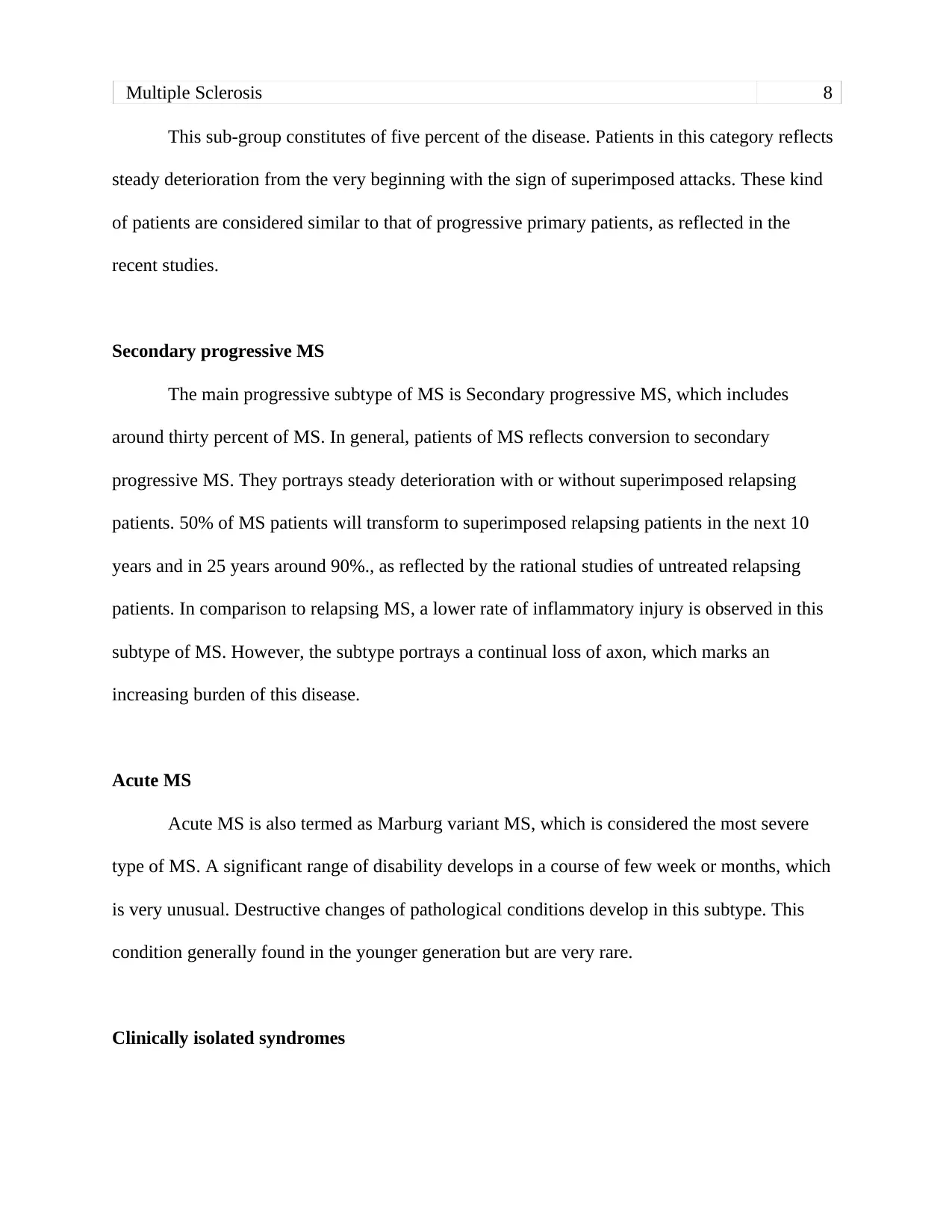
Multiple Sclerosis 8
This sub-group constitutes of five percent of the disease. Patients in this category reflects
steady deterioration from the very beginning with the sign of superimposed attacks. These kind
of patients are considered similar to that of progressive primary patients, as reflected in the
recent studies.
Secondary progressive MS
The main progressive subtype of MS is Secondary progressive MS, which includes
around thirty percent of MS. In general, patients of MS reflects conversion to secondary
progressive MS. They portrays steady deterioration with or without superimposed relapsing
patients. 50% of MS patients will transform to superimposed relapsing patients in the next 10
years and in 25 years around 90%., as reflected by the rational studies of untreated relapsing
patients. In comparison to relapsing MS, a lower rate of inflammatory injury is observed in this
subtype of MS. However, the subtype portrays a continual loss of axon, which marks an
increasing burden of this disease.
Acute MS
Acute MS is also termed as Marburg variant MS, which is considered the most severe
type of MS. A significant range of disability develops in a course of few week or months, which
is very unusual. Destructive changes of pathological conditions develop in this subtype. This
condition generally found in the younger generation but are very rare.
Clinically isolated syndromes
This sub-group constitutes of five percent of the disease. Patients in this category reflects
steady deterioration from the very beginning with the sign of superimposed attacks. These kind
of patients are considered similar to that of progressive primary patients, as reflected in the
recent studies.
Secondary progressive MS
The main progressive subtype of MS is Secondary progressive MS, which includes
around thirty percent of MS. In general, patients of MS reflects conversion to secondary
progressive MS. They portrays steady deterioration with or without superimposed relapsing
patients. 50% of MS patients will transform to superimposed relapsing patients in the next 10
years and in 25 years around 90%., as reflected by the rational studies of untreated relapsing
patients. In comparison to relapsing MS, a lower rate of inflammatory injury is observed in this
subtype of MS. However, the subtype portrays a continual loss of axon, which marks an
increasing burden of this disease.
Acute MS
Acute MS is also termed as Marburg variant MS, which is considered the most severe
type of MS. A significant range of disability develops in a course of few week or months, which
is very unusual. Destructive changes of pathological conditions develop in this subtype. This
condition generally found in the younger generation but are very rare.
Clinically isolated syndromes
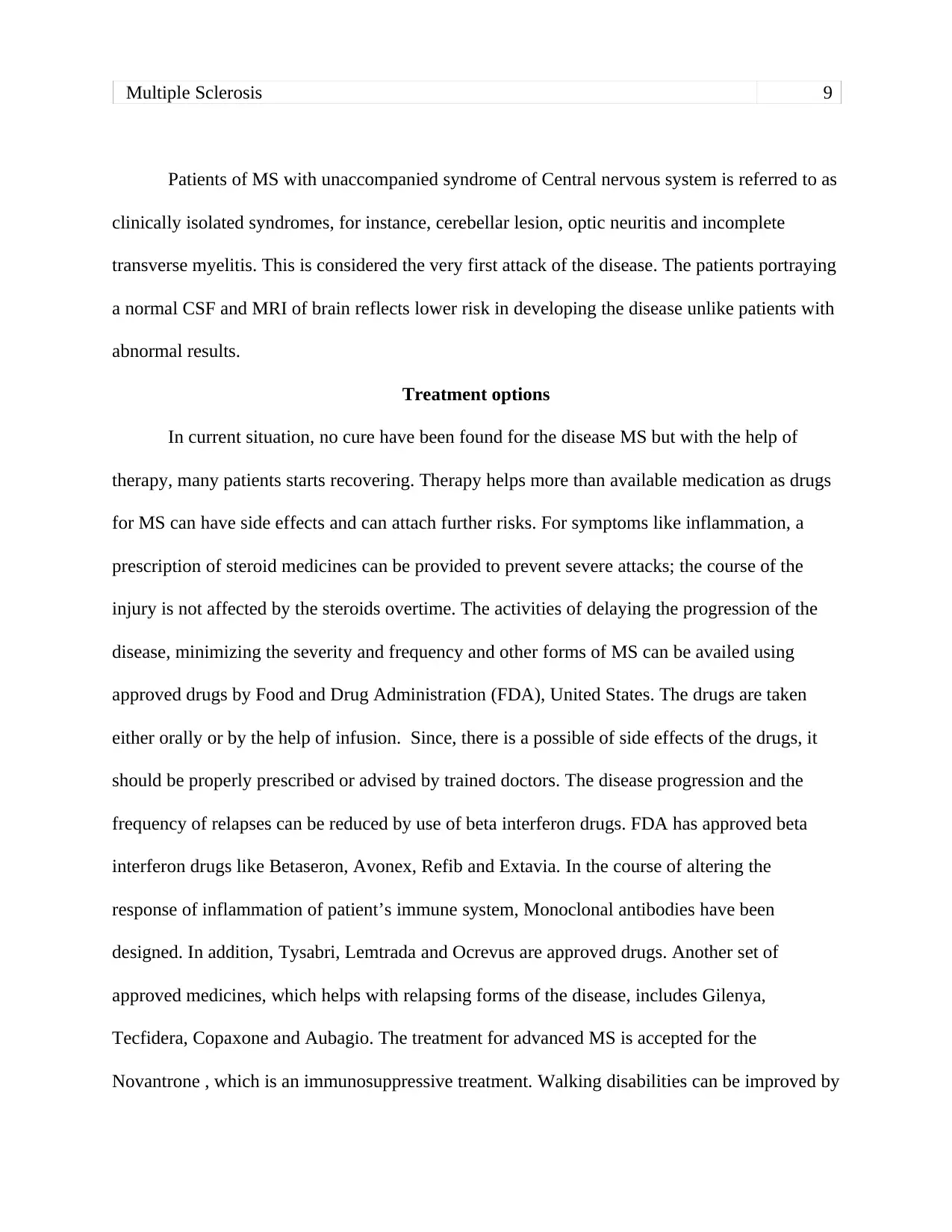
Multiple Sclerosis 9
Patients of MS with unaccompanied syndrome of Central nervous system is referred to as
clinically isolated syndromes, for instance, cerebellar lesion, optic neuritis and incomplete
transverse myelitis. This is considered the very first attack of the disease. The patients portraying
a normal CSF and MRI of brain reflects lower risk in developing the disease unlike patients with
abnormal results.
Treatment options
In current situation, no cure have been found for the disease MS but with the help of
therapy, many patients starts recovering. Therapy helps more than available medication as drugs
for MS can have side effects and can attach further risks. For symptoms like inflammation, a
prescription of steroid medicines can be provided to prevent severe attacks; the course of the
injury is not affected by the steroids overtime. The activities of delaying the progression of the
disease, minimizing the severity and frequency and other forms of MS can be availed using
approved drugs by Food and Drug Administration (FDA), United States. The drugs are taken
either orally or by the help of infusion. Since, there is a possible of side effects of the drugs, it
should be properly prescribed or advised by trained doctors. The disease progression and the
frequency of relapses can be reduced by use of beta interferon drugs. FDA has approved beta
interferon drugs like Betaseron, Avonex, Refib and Extavia. In the course of altering the
response of inflammation of patient’s immune system, Monoclonal antibodies have been
designed. In addition, Tysabri, Lemtrada and Ocrevus are approved drugs. Another set of
approved medicines, which helps with relapsing forms of the disease, includes Gilenya,
Tecfidera, Copaxone and Aubagio. The treatment for advanced MS is accepted for the
Novantrone , which is an immunosuppressive treatment. Walking disabilities can be improved by
Patients of MS with unaccompanied syndrome of Central nervous system is referred to as
clinically isolated syndromes, for instance, cerebellar lesion, optic neuritis and incomplete
transverse myelitis. This is considered the very first attack of the disease. The patients portraying
a normal CSF and MRI of brain reflects lower risk in developing the disease unlike patients with
abnormal results.
Treatment options
In current situation, no cure have been found for the disease MS but with the help of
therapy, many patients starts recovering. Therapy helps more than available medication as drugs
for MS can have side effects and can attach further risks. For symptoms like inflammation, a
prescription of steroid medicines can be provided to prevent severe attacks; the course of the
injury is not affected by the steroids overtime. The activities of delaying the progression of the
disease, minimizing the severity and frequency and other forms of MS can be availed using
approved drugs by Food and Drug Administration (FDA), United States. The drugs are taken
either orally or by the help of infusion. Since, there is a possible of side effects of the drugs, it
should be properly prescribed or advised by trained doctors. The disease progression and the
frequency of relapses can be reduced by use of beta interferon drugs. FDA has approved beta
interferon drugs like Betaseron, Avonex, Refib and Extavia. In the course of altering the
response of inflammation of patient’s immune system, Monoclonal antibodies have been
designed. In addition, Tysabri, Lemtrada and Ocrevus are approved drugs. Another set of
approved medicines, which helps with relapsing forms of the disease, includes Gilenya,
Tecfidera, Copaxone and Aubagio. The treatment for advanced MS is accepted for the
Novantrone , which is an immunosuppressive treatment. Walking disabilities can be improved by
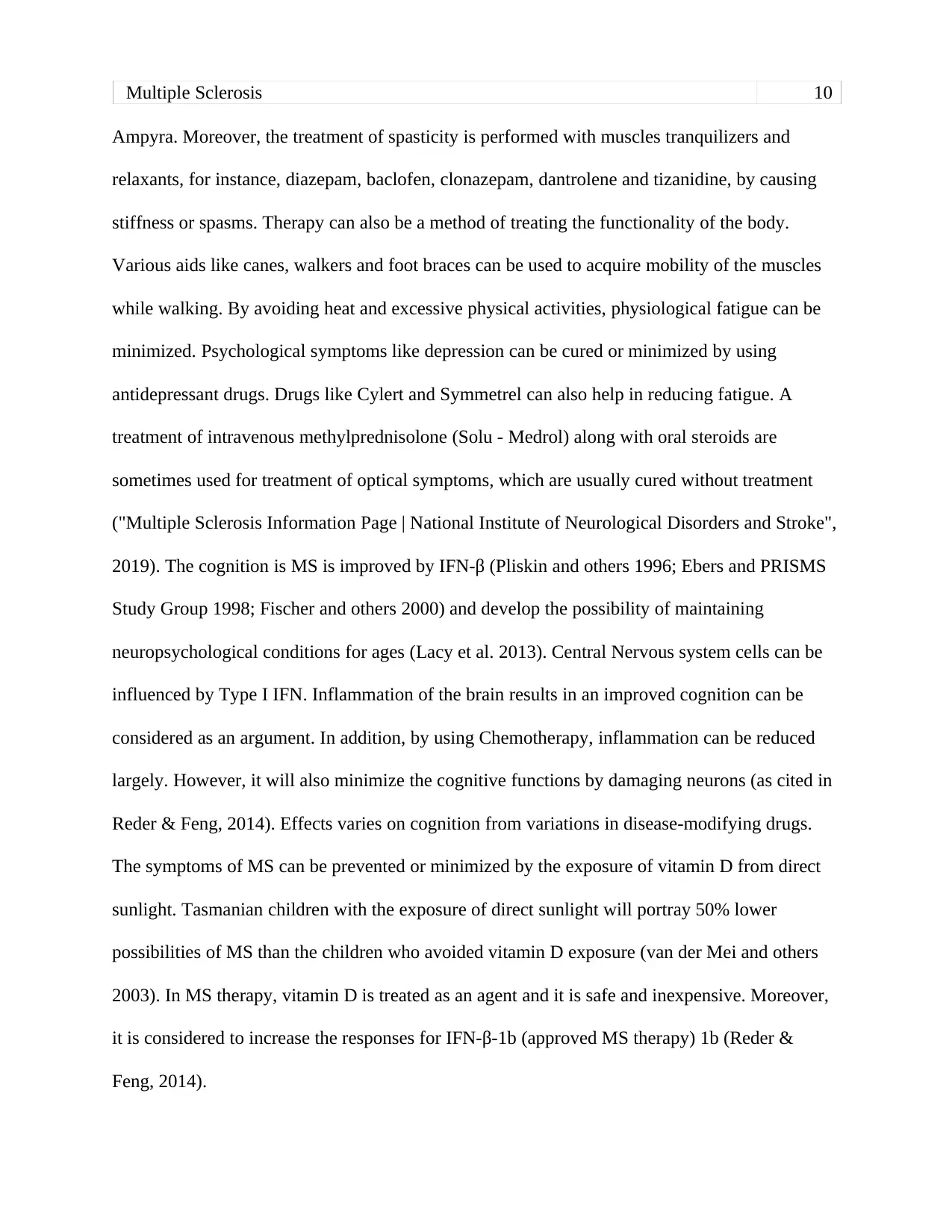
Multiple Sclerosis 10
Ampyra. Moreover, the treatment of spasticity is performed with muscles tranquilizers and
relaxants, for instance, diazepam, baclofen, clonazepam, dantrolene and tizanidine, by causing
stiffness or spasms. Therapy can also be a method of treating the functionality of the body.
Various aids like canes, walkers and foot braces can be used to acquire mobility of the muscles
while walking. By avoiding heat and excessive physical activities, physiological fatigue can be
minimized. Psychological symptoms like depression can be cured or minimized by using
antidepressant drugs. Drugs like Cylert and Symmetrel can also help in reducing fatigue. A
treatment of intravenous methylprednisolone (Solu - Medrol) along with oral steroids are
sometimes used for treatment of optical symptoms, which are usually cured without treatment
("Multiple Sclerosis Information Page | National Institute of Neurological Disorders and Stroke",
2019). The cognition is MS is improved by IFN-β (Pliskin and others 1996; Ebers and PRISMS
Study Group 1998; Fischer and others 2000) and develop the possibility of maintaining
neuropsychological conditions for ages (Lacy et al. 2013). Central Nervous system cells can be
influenced by Type I IFN. Inflammation of the brain results in an improved cognition can be
considered as an argument. In addition, by using Chemotherapy, inflammation can be reduced
largely. However, it will also minimize the cognitive functions by damaging neurons (as cited in
Reder & Feng, 2014). Effects varies on cognition from variations in disease-modifying drugs.
The symptoms of MS can be prevented or minimized by the exposure of vitamin D from direct
sunlight. Tasmanian children with the exposure of direct sunlight will portray 50% lower
possibilities of MS than the children who avoided vitamin D exposure (van der Mei and others
2003). In MS therapy, vitamin D is treated as an agent and it is safe and inexpensive. Moreover,
it is considered to increase the responses for IFN-β-1b (approved MS therapy) 1b (Reder &
Feng, 2014).
Ampyra. Moreover, the treatment of spasticity is performed with muscles tranquilizers and
relaxants, for instance, diazepam, baclofen, clonazepam, dantrolene and tizanidine, by causing
stiffness or spasms. Therapy can also be a method of treating the functionality of the body.
Various aids like canes, walkers and foot braces can be used to acquire mobility of the muscles
while walking. By avoiding heat and excessive physical activities, physiological fatigue can be
minimized. Psychological symptoms like depression can be cured or minimized by using
antidepressant drugs. Drugs like Cylert and Symmetrel can also help in reducing fatigue. A
treatment of intravenous methylprednisolone (Solu - Medrol) along with oral steroids are
sometimes used for treatment of optical symptoms, which are usually cured without treatment
("Multiple Sclerosis Information Page | National Institute of Neurological Disorders and Stroke",
2019). The cognition is MS is improved by IFN-β (Pliskin and others 1996; Ebers and PRISMS
Study Group 1998; Fischer and others 2000) and develop the possibility of maintaining
neuropsychological conditions for ages (Lacy et al. 2013). Central Nervous system cells can be
influenced by Type I IFN. Inflammation of the brain results in an improved cognition can be
considered as an argument. In addition, by using Chemotherapy, inflammation can be reduced
largely. However, it will also minimize the cognitive functions by damaging neurons (as cited in
Reder & Feng, 2014). Effects varies on cognition from variations in disease-modifying drugs.
The symptoms of MS can be prevented or minimized by the exposure of vitamin D from direct
sunlight. Tasmanian children with the exposure of direct sunlight will portray 50% lower
possibilities of MS than the children who avoided vitamin D exposure (van der Mei and others
2003). In MS therapy, vitamin D is treated as an agent and it is safe and inexpensive. Moreover,
it is considered to increase the responses for IFN-β-1b (approved MS therapy) 1b (Reder &
Feng, 2014).
Secure Best Marks with AI Grader
Need help grading? Try our AI Grader for instant feedback on your assignments.
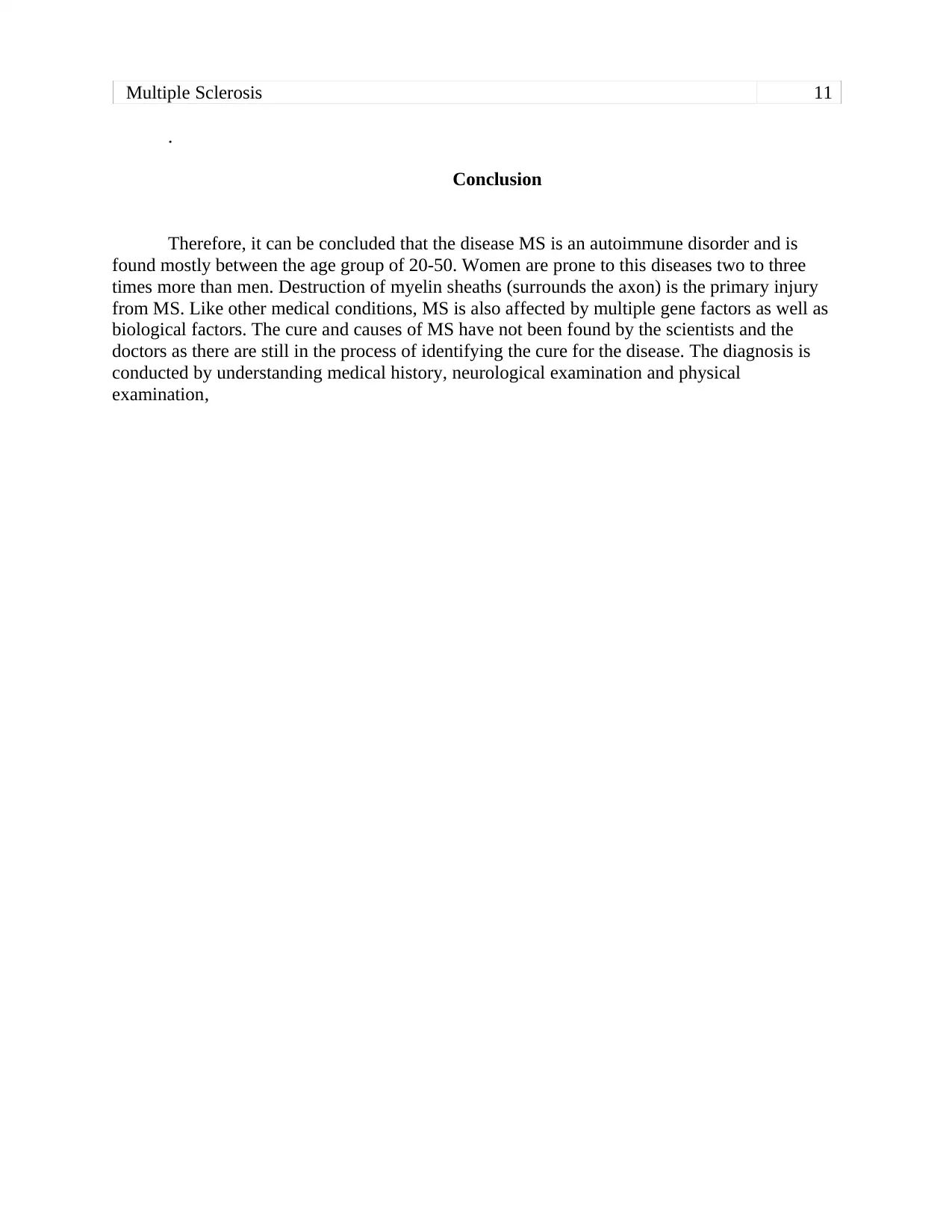
Multiple Sclerosis 11
.
Conclusion
Therefore, it can be concluded that the disease MS is an autoimmune disorder and is
found mostly between the age group of 20-50. Women are prone to this diseases two to three
times more than men. Destruction of myelin sheaths (surrounds the axon) is the primary injury
from MS. Like other medical conditions, MS is also affected by multiple gene factors as well as
biological factors. The cure and causes of MS have not been found by the scientists and the
doctors as there are still in the process of identifying the cure for the disease. The diagnosis is
conducted by understanding medical history, neurological examination and physical
examination,
.
Conclusion
Therefore, it can be concluded that the disease MS is an autoimmune disorder and is
found mostly between the age group of 20-50. Women are prone to this diseases two to three
times more than men. Destruction of myelin sheaths (surrounds the axon) is the primary injury
from MS. Like other medical conditions, MS is also affected by multiple gene factors as well as
biological factors. The cure and causes of MS have not been found by the scientists and the
doctors as there are still in the process of identifying the cure for the disease. The diagnosis is
conducted by understanding medical history, neurological examination and physical
examination,

Multiple Sclerosis 12
References
Scolding, N. J., Pasquini, M., Reingold, S. C., Cohen, J. A., International Conference on
Cell-Based Therapies for Multiple Sclerosis, International Conference on Cell-Based
Therapies for Multiple Sclerosis, International Conference on Cell-Based Therapies for
Multiple Sclerosis (2017). Cell-based therapeutic strategies for multiple sclerosis. Brain:
a journal of neurology, 140(11), 2776-2796.
Multiple Sclerosis | MS | MedlinePlus. (2019). Retrieved from
https://medlineplus.gov/multiplesclerosis.html
Joy, J., & Johnston, R. (2001). Multiple sclerosis. Washington, D.C.: National Academy Press.
What Causes MS? (2019). Retrieved from
https://www.nationalmssociety.org/What-is-MS/What-Causes-MS
Multiple Sclerosis Information Page | National Institute of Neurological Disorders and Stroke.
(2019). Retrieved from
https://www.ninds.nih.gov/Disorders/All-Disorders/Multiple-Sclerosis-Information-Page
Pliskin NH, Hamer DP, Goldstein DS, Towle VL, Reder AT, Noronha A, Arnason BG
Neurology. 1996 Dec; 47(6):1463-8.
Pliskin, N. H., Hamer, D. P., Goldstein, D. S., Towle, V. L., Reder, A. T., Noronha, A., &
Arnason, B. G. W. (1996). Improved delayed visual reproduction test performance in
multiple sclerosis patients receiving interferon beta-1b. Neurology, 47(6), 1463-1468.
Randomised double-blind placebo-controlled study of interferon beta-1a in relapsing/remitting
multiple sclerosis. PRISMS (Prevention of Relapses and Disability by Interferon beta-1a
Subcutaneously in Multiple Sclerosis) Study Group.
Lancet. 1998 Nov 7; 352(9139):1498-504.
Fischer JS, Priore RL, Jacobs LD, Cookfair DL, Rudick RA, Herndon RM, Richert JR, Salazar
AM, Goodkin DE, Granger CV, Simon JH, Grafman JH, Lezak MD, O'Reilly Hovey KM,
Perkins KK, Barilla-Clark D, Schacter M, Shucard DW, Davidson AL, Wende KE,
Bourdette DN, Kooijmans-Coutinho MF
Ann Neurol. 2000 Dec; 48(6):885-92.
Lacy M, Hauser M, Pliskin N, Assuras S, Valentine MO, Reder A
Mult Scler. 2013 Nov; 19(13):1765-72.
Petzold, A. Mondria, T. Kuhle J, Rocca MA, Cornelissen J, te Boekhorst P, Lowenberg B,
Giovannoni G, Filippi M, Kappos L, Hintzen R
Ann Neurol. 2010 Dec; 68(6):806-15.
References
Scolding, N. J., Pasquini, M., Reingold, S. C., Cohen, J. A., International Conference on
Cell-Based Therapies for Multiple Sclerosis, International Conference on Cell-Based
Therapies for Multiple Sclerosis, International Conference on Cell-Based Therapies for
Multiple Sclerosis (2017). Cell-based therapeutic strategies for multiple sclerosis. Brain:
a journal of neurology, 140(11), 2776-2796.
Multiple Sclerosis | MS | MedlinePlus. (2019). Retrieved from
https://medlineplus.gov/multiplesclerosis.html
Joy, J., & Johnston, R. (2001). Multiple sclerosis. Washington, D.C.: National Academy Press.
What Causes MS? (2019). Retrieved from
https://www.nationalmssociety.org/What-is-MS/What-Causes-MS
Multiple Sclerosis Information Page | National Institute of Neurological Disorders and Stroke.
(2019). Retrieved from
https://www.ninds.nih.gov/Disorders/All-Disorders/Multiple-Sclerosis-Information-Page
Pliskin NH, Hamer DP, Goldstein DS, Towle VL, Reder AT, Noronha A, Arnason BG
Neurology. 1996 Dec; 47(6):1463-8.
Pliskin, N. H., Hamer, D. P., Goldstein, D. S., Towle, V. L., Reder, A. T., Noronha, A., &
Arnason, B. G. W. (1996). Improved delayed visual reproduction test performance in
multiple sclerosis patients receiving interferon beta-1b. Neurology, 47(6), 1463-1468.
Randomised double-blind placebo-controlled study of interferon beta-1a in relapsing/remitting
multiple sclerosis. PRISMS (Prevention of Relapses and Disability by Interferon beta-1a
Subcutaneously in Multiple Sclerosis) Study Group.
Lancet. 1998 Nov 7; 352(9139):1498-504.
Fischer JS, Priore RL, Jacobs LD, Cookfair DL, Rudick RA, Herndon RM, Richert JR, Salazar
AM, Goodkin DE, Granger CV, Simon JH, Grafman JH, Lezak MD, O'Reilly Hovey KM,
Perkins KK, Barilla-Clark D, Schacter M, Shucard DW, Davidson AL, Wende KE,
Bourdette DN, Kooijmans-Coutinho MF
Ann Neurol. 2000 Dec; 48(6):885-92.
Lacy M, Hauser M, Pliskin N, Assuras S, Valentine MO, Reder A
Mult Scler. 2013 Nov; 19(13):1765-72.
Petzold, A. Mondria, T. Kuhle J, Rocca MA, Cornelissen J, te Boekhorst P, Lowenberg B,
Giovannoni G, Filippi M, Kappos L, Hintzen R
Ann Neurol. 2010 Dec; 68(6):806-15.
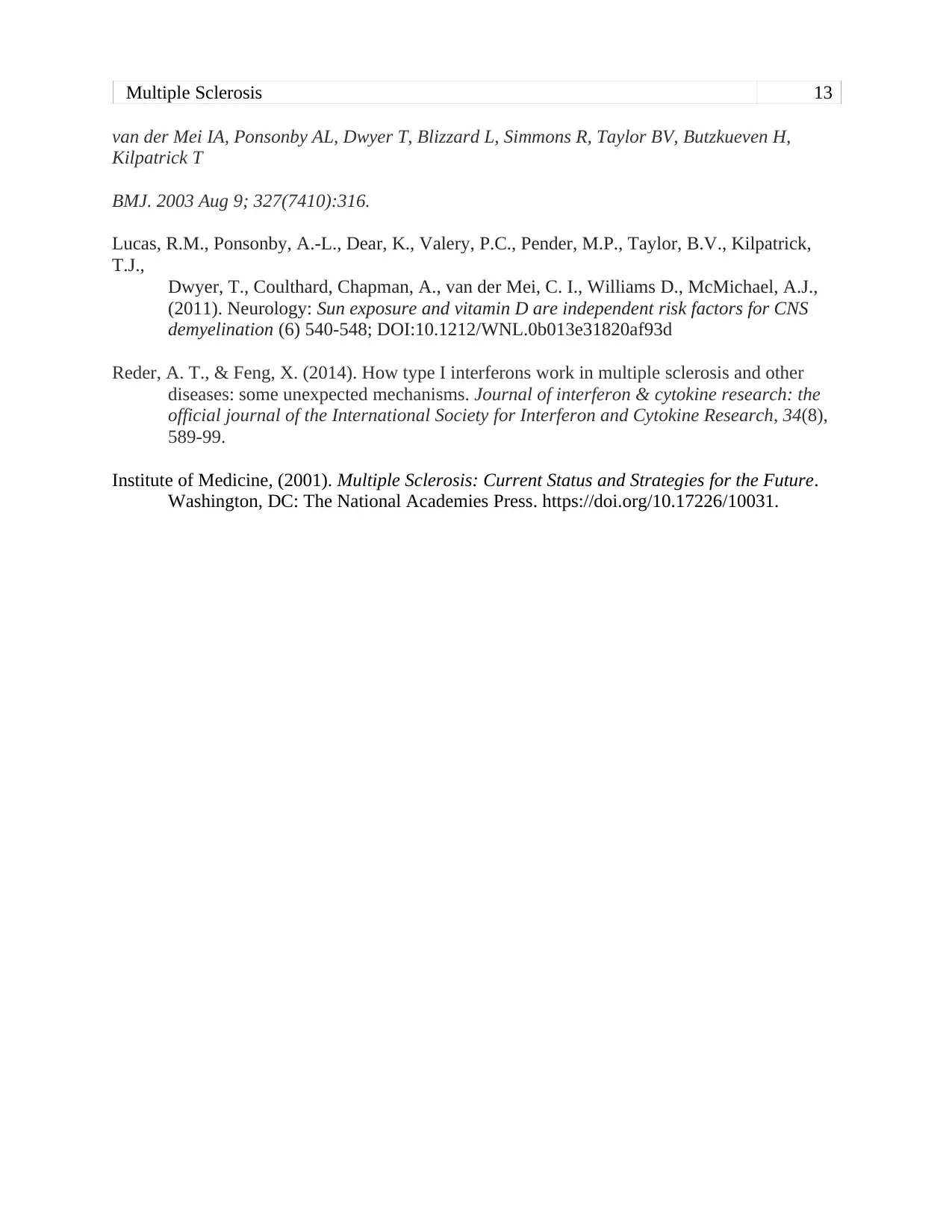
Multiple Sclerosis 13
van der Mei IA, Ponsonby AL, Dwyer T, Blizzard L, Simmons R, Taylor BV, Butzkueven H,
Kilpatrick T
BMJ. 2003 Aug 9; 327(7410):316.
Lucas, R.M., Ponsonby, A.-L., Dear, K., Valery, P.C., Pender, M.P., Taylor, B.V., Kilpatrick,
T.J.,
Dwyer, T., Coulthard, Chapman, A., van der Mei, C. I., Williams D., McMichael, A.J.,
(2011). Neurology: Sun exposure and vitamin D are independent risk factors for CNS
demyelination (6) 540-548; DOI:10.1212/WNL.0b013e31820af93d
Reder, A. T., & Feng, X. (2014). How type I interferons work in multiple sclerosis and other
diseases: some unexpected mechanisms. Journal of interferon & cytokine research: the
official journal of the International Society for Interferon and Cytokine Research, 34(8),
589-99.
Institute of Medicine, (2001). Multiple Sclerosis: Current Status and Strategies for the Future.
Washington, DC: The National Academies Press. https://doi.org/10.17226/10031.
van der Mei IA, Ponsonby AL, Dwyer T, Blizzard L, Simmons R, Taylor BV, Butzkueven H,
Kilpatrick T
BMJ. 2003 Aug 9; 327(7410):316.
Lucas, R.M., Ponsonby, A.-L., Dear, K., Valery, P.C., Pender, M.P., Taylor, B.V., Kilpatrick,
T.J.,
Dwyer, T., Coulthard, Chapman, A., van der Mei, C. I., Williams D., McMichael, A.J.,
(2011). Neurology: Sun exposure and vitamin D are independent risk factors for CNS
demyelination (6) 540-548; DOI:10.1212/WNL.0b013e31820af93d
Reder, A. T., & Feng, X. (2014). How type I interferons work in multiple sclerosis and other
diseases: some unexpected mechanisms. Journal of interferon & cytokine research: the
official journal of the International Society for Interferon and Cytokine Research, 34(8),
589-99.
Institute of Medicine, (2001). Multiple Sclerosis: Current Status and Strategies for the Future.
Washington, DC: The National Academies Press. https://doi.org/10.17226/10031.
1 out of 13
Related Documents
Your All-in-One AI-Powered Toolkit for Academic Success.
+13062052269
info@desklib.com
Available 24*7 on WhatsApp / Email
![[object Object]](/_next/static/media/star-bottom.7253800d.svg)
Unlock your academic potential
© 2024 | Zucol Services PVT LTD | All rights reserved.




